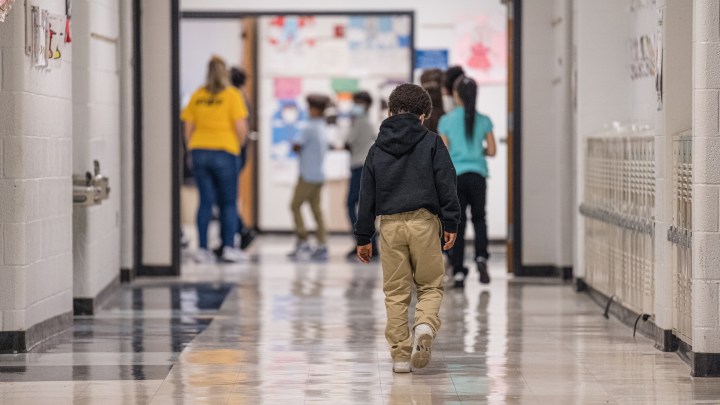
How one elementary principal is dealing with hiring staff and kids’ learning loss
How one elementary principal is dealing with hiring staff and kids’ learning loss

Schools in the U.S. are back to in-person classes, but many districts continue to struggle with hiring. The Economic Policy Institute tracked trends in teacher wages and compensation and found that “teachers are paid less (in weekly wages and total compensation) than their nonteacher college-educated counterparts.”
“Marketplace” host Kai Ryssdal spoke with Jessica Gomez, principal at Alice Birney Elementary School in the Colton Joint Unified School District in Southern California to find out how Gomez and her staff are managing. The following is an edited transcript of their conversation.
Kai Ryssdal: How are things in elementary school these days? I mean, we should say you’re active in the National Association of Elementary School Principals, so it’s not just your elementary school I’m asking about.
Jessica Gomez: Yeah, well, so elementary school is busy every single day. You have a calendar, but you rarely follow it.
Ryssdal: I have vague memories. So, more of the point, how are the kids?
Gomez: You know, the kids are much better than they were last year. Now, granted, we do have some post-pandemic effects, right, of trauma that a lot of our students experience, but they’re doing so much better than they were last year for sure.
Ryssdal: Good. That is good to hear. Now, let me ask you the labor market question: How are the teachers and staff doing?
Gomez: So teachers — it’s rough, it’s tough. The reason why it’s a little bit harder than typical, than pre-pandemic is because we’re having to catch kids up. And it’s just a matter of doing everything I can as a principal to keep morale high, and if we show up as our best selves, that’s how we show up.
Ryssdal: The story, of course, of teachers through the pandemic has been how hard it’s been for them and how disaffected a lot of them became. Do you have enough people to staff your classrooms?
Gomez: So, I have enough people to staff my classrooms. Now, I am also a dual-language immersion school. So, to fill dual-language immersion positions is even more difficult because you have to have a special bilingual credential. And one of my teachers actually just got hired as an art teacher for the district. So now I’m having to replace her with a dual-immersion teacher. I have one candidate — one. And, you know, ask a few years ago, I mean, we would get a whole list of applicants.
Ryssdal: What happens if your phone rings at 6 — and I don’t know if the principal gets these calls, somebody does, right? — that says: “Listen, our fourth grade teacher is out, maybe with COVID, and the second grade teacher has to take care of our own child.” I mean, what do you do? Do you have enough subs?
Gomez: Uh, no. So it’s almost like you just looked at my phone this morning. And for any principal that’s listening out there, that is the story of our lives every single day. You know, it’s manageable when it’s one class, but when you’re getting texts in the morning, by one teacher, two teachers, three teachers — now that really starts to become a challenge. I actually don’t even check my phone when I first get up because I don’t even want to see how many texts I have. I give myself some time in the morning before I actually get into that headspace of “I have to problem-solve now.”
Ryssdal: Yeah, you gotta manage your phone. Yeah, so most of your kids are students of color, right?
Gomez: Yes.
Ryssdal: So let me ask you a future question, right, going back to the learning-loss thing. This is a little depressing, but how long do you think it will take for these kids to catch up?
Gomez: You know, that’s hard to say, but it’s definitely going to be a few years out. We are scrambling as a school, as a district. And a lot of our students, they went through some things, and we’re still dealing with that, in terms of the mental health part of it. And there’s going to be some things that we’re going to have to put into place that is thinking outside the box and being very strategic on what we do with the time we have with them during the school day.
Ryssdal: Let me end on a personal question, if I might, Mrs. Gomez: Obviously, the pandemic was really hard on kids, really hard on teachers. I imagine it was really hard on administrators like yourself as well. What kept you going through the last two and a half years?
Gomez: You know, I think it was within me to be there for them. And I’ve been here at the school site for 10 years, so I have a very strong relationship with the students and the staff, and I couldn’t see myself walking away from that, even as challenging as it has been. I mean, you’ve talked about teacher burnout, talk about principal burnout. But we need to continue to take care of ourselves and be able to help lead our staffs in a way that we would hope they can lead their students.
There’s a lot happening in the world. Through it all, Marketplace is here for you.
You rely on Marketplace to break down the world’s events and tell you how it affects you in a fact-based, approachable way. We rely on your financial support to keep making that possible.
Your donation today powers the independent journalism that you rely on. For just $5/month, you can help sustain Marketplace so we can keep reporting on the things that matter to you.











